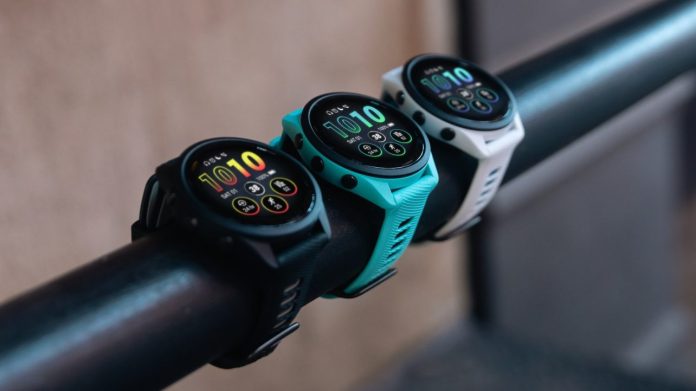Garmin, a titan in the wearable technology landscape, consistently pushes the boundaries of innovation. 2024 witnessed a flurry of updates across its diverse product lines, from software refinements to groundbreaking hardware advancements.
As we peer into the horizon of 2025, a wave of anticipation washes over the tech-savvy and fitness-minded alike. What exciting innovations will Garmin unveil next? Let’s delve into the concrete clues, the whispered rumors, and the educated speculation that paint a picture of Garmin’s ambitious roadmap for the year ahead.
Instinct 3: Rugged Evolution
The venerable Instinct 2, a stalwart companion for outdoor enthusiasts, is poised for a refresh. Recent leaks and official hints point towards the imminent arrival of the Garmin Instinct 3. A purported prototype image surfaced online, sparking debate about its authenticity. While some dismissed it as a mirage, others believed it offered a glimpse into the future.
Garmin’s support sites inadvertently revealed the existence of a 45mm Instinct 3 Solar model, solidifying the continuation of its solar-powered legacy. The inclusion of the Instinct 3 in Garmin Pay-compatible devices listings hinted at the availability of both solar and non-solar variants, catering to diverse user preferences.
Building upon the foundation of its predecessor, the Instinct 3 is expected to offer a range of sizes, likely mirroring the Instinct 2 with 40mm, 45mm, and 51mm options, ensuring a comfortable fit for various wrist sizes. Drawing inspiration from the advancements seen in the Enduro 3 and Fenix 8, the Instinct 3 could boast a significant 50% improvement in solar efficiency, achieved through more efficient, better-integrated solar panels. Multi-band GNSS, currently a premium feature, is anticipated to become standard, promising greater accuracy and reliability in challenging environments.
The integration of the Elevate 5 heart rate sensor is expected, though ECG functionality might be absent due to the nature of the watch’s materials. Leaked images hinted at reduced bezels and a larger display, improving readability and data field presentation. An LED flashlight across all sizes, a feature borrowed from the Fenix 8 and Instinct 2X, will enhance usability in low-light conditions. Expect incremental improvements in battery life, durability, and interface responsiveness.
Tactix 8 AMOLED: Tactical Refinement
Following the established pattern of releasing Tactix models shortly after the latest Fenix, the Tactix 8 AMOLED is anticipated to make its appearance in the near future. Connect IQ developer documentation revealed the existence of two size options: 47mm and 51mm, catering to diverse wrist preferences. The Tactix 8 is set to embrace the AMOLED display technology, building upon the success of the Tactix 7 AMOLED Edition.
True to its tactical heritage, the Tactix 8 is expected to retain its core strengths, including robust MIL-STD-810 compliance and advanced tactical functionalities. However, it will likely incorporate several key features from the Fenix 8, such as a microphone and speaker, enhanced dive capabilities, and the latest user interface refinements.
Fenix 8 Pro and the MicroLED Revolution
The fleeting appearances of the Fenix 8 Pro and Fenix 8 MicroLED in Garmin’s Connect app and developer documentation hinted at their development. While details remain scarce, these listings suggest Garmin may be accelerating its Pro lineup timeline, potentially paving the way for a 2025 release.
If integrated into the Fenix 8 Pro lineup, MicroLED displays could revolutionize wearable technology. MicroLED surpasses OLED in terms of brightness, ensuring exceptional outdoor readability even in the harshest sunlight, a critical advantage for outdoor enthusiasts. Composed of inorganic materials, MicroLED displays exhibit superior durability and are significantly less susceptible to burn-in, promising extended longevity.
MicroLED consumes less power than OLED, even at peak brightness, enabling longer battery life without compromising display quality. The inherent thinness of MicroLED technology allows for slimmer watch designs or the incorporation of larger batteries, further extending endurance.
While MicroLED technology holds immense promise, its widespread adoption has been hindered by production challenges and high costs. Garmin’s premium pricing strategy could mitigate these costs, potentially making it a pioneer in bringing this cutting-edge technology to the wearable market.
While details remain shrouded in mystery, the potential integration of MicroLED technology could redefine the benchmark for smartwatch displays. This technology promises to deliver unparalleled clarity and brightness while maintaining the energy efficiency that has become synonymous with Garmin’s MIP displays. However, the 2025 release of MicroLED-equipped watches remains uncertain, as even tech giants like Apple have encountered challenges in scaling and implementing this technology.
Forerunner 975/275: Elevating Performance
The next generation of Forerunner watches is expected to incorporate the latest heart rate sensor technology, namely the Elevate Gen 5, complete with ECG support. Other potential enhancements include wireless Qi charging, eliminating the need for proprietary chargers, and adding a layer of convenience. LTE connectivity, previously seen in the 945 LTE, could make a triumphant return, enabling features like real-time tracking, seamless messaging, and potentially even phone-free music streaming.
The inclusion of an LED flashlight, a popular feature in the Fenix and Instinct series, could further enhance the Forerunner’s versatility. Currently, the Forerunner 265 caters to diverse wrist sizes with two options, while the 965 offers a single size that some users, particularly women, may find overly large. The Forerunner 975 could address this by offering both small and large variants, ensuring a comfortable fit for a wider audience.
MARQ (Gen 3): Luxury Redefined
The Garmin MARQ line stands apart with its luxurious materials, including grade-5 titanium and sapphire glass. However, it has lagged behind in adopting the latest hardware and software advancements found in Garmin’s high-end Fenix models. While the MARQ series embodies premium craftsmanship, it currently lacks the Elevate Gen 5 heart rate sensor with ECG, the convenient built-in LED flashlight, the user-friendly microphone and speaker, the refined user interfaces, and other cutting-edge features available in the Fenix and Epix Pro lines.
As the anticipated MARQ (Gen 3) approaches in 2025, addressing these gaps will be crucial. The potential integration of groundbreaking technologies, such as microLED displays or solar AMOLED, could further solidify its position in the high-end wearable market.
Venu 4: Smart Evolution
Following the release of the Venu 3 in late 2023, a Venu 4 could potentially grace the market in late 2025 or early 2026. While the Venu 3 boasts the latest heart rate sensor with ECG, it currently lacks multi-band GNSS. While hardware improvements are expected, the Venu 4 will likely prioritize enhancements to its microphone, speaker, and overall smart features.
Currently, the Venu 3 enables voice control of connected smartphone assistants (Siri and Google) but does not support voice commands for controlling the watch itself – a feature introduced by Garmin with the Fenix 8.
A Word of Caution:
It’s important to remember that these are projections based on leaks, patterns, and educated speculation. Garmin may have surprises in store, as demonstrated by the unexpected release of two versions of the Lily 2 earlier this year.
The Future is Bright:
Garmin’s 2025 roadmap promises a wave of exciting advancements in both hardware and technology, from the anticipated arrival of the Instinct 3 to the tantalizing prospect of MicroLED displays. While some products remain shrouded in mystery, the available clues paint a picture of another impactful year for Garmin.
Which upcoming release excites you the most? Share your thoughts and join the conversation!

